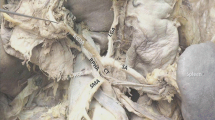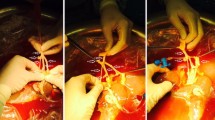Abstract
A variation in liver vascularization was discovered in a 50-year-old man. A single common hepatic artery was found to be responsible for vascularization of the entire liver. This artery was unusual in that it formed the first branch of the superior mesenteric artery, crossing the portal trunk shortly after its origin, and passed in front of the portal vein to reach the hilum of the liver, where it divided into a right and a left branch. This artery was a true common hepatic artery because a gastroduodenal artery emerged from it 2 cm after its origin. A common hepatic artery originating from the mesenteric artery and passing in front of the portal vein has never been described before. The patient had a second anatomical variation: the left gastric artery and the splenic artery arose directly from the aorta, without celiac trunk separation. This observation confirms the importance of carrying out a precise vascular assessment before all types of hepatic or pancreatic surgery, to identify possible variations in the number or trajectory of hepatic arteries.
Similar content being viewed by others
Avoid common mistakes on your manuscript.
Case report
The patient was a 50-year-old man presenting an obstructive left colon tumor associated with multiple hepatic metastases in both lobes. The treatment selected consisted of ablation of the primary tumor by left colectomy and the insertion during surgery of a catheter into the hepatic artery for chemotherapy. This decision was based on the large number of hepatic lesions. Arteriography or angiography must be carried out before the implantation of an arterial artery for chemotherapy, to determine the vascularization pattern of the liver [22].
The catheter must be positioned in the hepatic artery proper, via the gastroduodenal artery, to ensure that the chemotherapy product diffuses throughout the hepatic parenchyma. All the other accessory hepatic arteries must be identified and linked.
Angiography (with reconstruction) (Figs. 1, 2, 3, 4) demonstrated atypical liver vascularization, with no separate celiac trunk. The splenic artery and the left gastric artery arose separately and directly from the aorta. A common hepatic artery originating from the right side of the superior mesenteric artery was responsible for vascularization of the entire liver. The patient had no right hepatic artery or left hepatic artery. The trajectory of this artery was extremely unusual as it passed in front of the portal trunk, whereas the right hepatic artery (which may arise from the superior mesenteric artery) is always found behind the portal trunk, and lateralized on the right.
This patient underwent surgery and the arterial catheter for chemotherapy was inserted into the common hepatic artery via the gastroduodenal artery. Postsurgical arteriography confirmed that the catheter had been correctly positioned.
Discussion
The arterial vascularization of the liver and variations of the hepatic artery had been reported on many occasions, beginning with Haller’s description of variations of the celiac trunk in 1756 [10], and including the reports by Adachi in 1928 [1], Flint in 1923 [8] and Michels in 1955 [16].
In 70% of cases, the liver is vascularized by a median hepatic artery, derived from the celiac trunk, which divides, generally in the middle section of the hepatic pedicle, into a branch destined for the left lobe and a branch destined for the right lobe of the liver [5, 7, 11].
In 1966, Michels [17] described and classified ten anatomical variations observed in 200 autopsies (Fig. 5). This classification was completed by Hiatt in 1994.
The persistence and/or abnormal regression of the embryonic hepatic arteries (of which there are three) account for the most frequent variations [2, 4]. Two aberrant types of hepatic artery are particularly common. An “accessory” hepatic artery is a vestigial left or right embryonic artery that coexists with the normal common hepatic artery. A “replacement” artery is an embryonic artery that persists after birth in the absence of a common hepatic artery originating from the celiac trunk. However, some studies [9, 18] have shown that accessory hepatic arteries vascularize a specific hepatic territory, the size of which depends on their diameter and that these arteries should therefore be considered to be replacement arteries.
The existence of a common hepatic artery vascularizing the entire liver but not originating in the celiac trunk has been reported in other series, and accounts for 2–5% of cases [11, 20, 23]. If this common hepatic artery originates from the superior mesenteric artery, it is classified as type IX according to the classification of Michels (accounting for 2.5% of cases in this series) or as type V according to the classification of Hiatt (1.5% of the series). Embryology may account for this variation in the origin of the hepatic artery, but not for the trajectory of the artery observed in this case. Indeed, if partial persistence of the ventral longitudinal anastomosis is observed, fusing the future superior mesenteric and hepatic arteries, it may be considered a hepato-mesenteric trunk independent of the celiac trunk [2]. In this case, the type of variation encountered in the common hepatic artery resembles that of type IX, but the situation is different. This artery reaches the hepatic pedicle by passing in front of the portal vein, rather than behind it and to the right like a right hepatic artery originating from the superior mesenteric artery (Fig. 6). This case therefore concerns a variation in the origin of the common hepatic artery, with the division of the hepatic artery proper and the gastroduodenal artery occurring in a modal position.
Other studies have also reported Michels’ type IX variation, but always with the hepatic artery passing behind the portal vein: Sponza [21] in 2% of cases in a series of patients undergoing arteriography; Covey [6] identified two cases (0.3%) of common hepatic arteries originating from the superior mesenteric artery in a series of 600 patients and Koops [15] identified this situation in 2% of a series of 604 arteriographies and described a single case [13].
This trajectory, with a common hepatic artery originating from the superior mesenteric artery passing in front of the portal vein, has never before been described. Only one case [19] of an accessory right hepatic artery in such a position has been described, and this artery did not ensure vascularization of the entire liver.
During surgery, this artery was dissected to determine its trajectory and for the insertion of an arterial catheter for chemotherapy. It was found to correspond to the first branch of the superior mesenteric artery on the right side, originating 3 mm below the ostium. It followed a vertical, ascending trajectory whereas accessory right hepatic arteries follow an ascending but oblique trajectory, turning towards the right for positioning behind and to the right of the portal trunk. At its emergence, at the upper edge of the pancreas, this artery crossed the portal trunk, positioning itself in front of this structure. It therefore occupied the position of a common hepatic artery, reaching the liver hilum and separating into a left and a right branch. It gave rise to the gastroduodenal artery about 25 mm after its origin (Fig. 6).
According to Jones [12], variations in one of the three arteries of the celiac trunk are associated with at least one other variation in 46% of cases. It is therefore necessary to be extremely vigilant if a variation is discovered during the perioperative period. In the case reported here, there was another arterial variation associated with an abnormal trajectory of the common hepatic artery. Indeed, no separate celiac trunk could be identified and the left gastric artery and the splenic artery arose directly from the aorta (Fig. 3).
In the series of 180 livers dissected with a view to transplantation studied by Jones, the absence of a celiac trunk, with the left gastric and splenic arteries arising directly from the aorta was noted in 1% of cases.
This case confirms the considerable diversity of variations of liver arterial vascularization, in terms of both the number of arteries responsible for liver vascularization and their trajectory. In this case, in which it had been decided to insert an arterial catheter for chemotherapy, particular attention was paid to presurgical angiography, to determine the vascularization pattern of the liver. The systematic use of this approach should be recommended for all liver surgery, as is the case for transplantation [3, 14], but also for pancreatic surgery, which might lead to damage to a hepatic artery in an unusual position.
References
Adachi B (1928) Das Arteriensystem der Japaner. Kenkyusha Press, Kyoto, Band II, 46–60
Barth M, Tongio J, Warter P (1976) Interprétation embryologique de l’anatomie des artères digestives. Ann Radiol 19:305–313
Chevallier JM (1999) Anatomie des artères digestives. In: Kieffer E, Parc E (ed) Chirurgie des artères digestives. Editions AERCV, pp 3–22
Chevallier JM, Hannoun L (1991) Anatomic bases for liver transplantation. Surg Radiol Anat 13:7–16
Couinaud C (1957) Le foie: études anatomiques et chirurgicales. Masson, Paris, pp 71–74
Covey AM, Brody LA, Maluccio MA, Getrajdman GI, Brown KT (2002) Variant hepatic arterial anatomy revisited: digital subtraction angiography performed in 600 patients. Radiology 224:542–547
Denys A, Sauvanet A, Wicky S, Schnyder P, Belhghiti J (2002) Anatomie chirurgicale du foie. J Radiol 83:205–218
Flint ER (1923) Abnormalities of the right hepatic, cystic and gastroduodenal arteries and of the bile ducts. Br J Surg 10:509–519
Gupta SC, Gupta CD, Gupta SB (1979) Intrahepatic supply pattern in cases of double hepatic arteries: a study by corrosion casts. Anat Anz 146:166–170
Haller A (1756) Icones anatomicae in quibus praecipae partes corporis humani delineate proponuntur et arteriarum potissimum historia contineur. Vandenhoeck, Gottingen, Vol VIII, 270
Hiatt JR, Gabbay J, Busuttil RW (1994) Surgical anatomy of the hepatic arteries in 1000 cases. Ann Surg 220:50–52
Jones RM, Hardy KJ (2001) The hepatic artery: a reminder of surgical anatomy. J R Coll Surg Edinb 46:168–170
Kahraman G, Marur T, Tanyeli E, Yildirim M (2001) Hepatomesenteric trunk. Surg Radiol Anat 23:433–435
Kishi Y, Sugawara Y, Kaneko J, Akamatsu N, Imamura H, Asato H, Kokudo N, Makuuchi M (2004) Hepatic arterial anatomy for right liver procurement from living donors. Liver Transpl 10:129–133
Koops A, Wojciechowski B, Broering DC, Adam G, Krupski-Berdien G (2004) Anatomic variations of the hepatic arteries in 604 selective celiac and superior mesenteric angiographies. Surg Radiol Anat 26:239–244
Michels NA (1955) Blood supply and anatomy of the upper abdominal organs with a descriptive atlas. JB Lippincott Co, Philadelphia-Montreal, pp 236–247
Michels NA (1966) Newer anatomy of the liver and its variant blood supply and collateral circulation. Am J Surg 112:337–347
Miyaki T, Sakagami S, Ito H (1989) Intrahepatic territory of the accessory hepatic artery in human. Acta Anat 136:34–37
Nagino M, Hayakawa N, Kitagawa S, Dohke M, Nimura Y (1993) Right anterior hepatic artery arising from the superior mesenteric artery: a case report. Hepatogastroenterology 40:407–409
Rong GH, Sindelar WF (1987) Aberrant peripancreatic arterial anatomy. Considerations in performing pancreatectomy for malignant neoplasms. Am Surg 53:726–729
Sponza M, Pozzi Mucelli R, Pozzi Mucelli F (1993) Arterial anatomy of the celiac trunk and the superior mesenteric artery with computerized tomography. Radiol Med 86:260–267
Tono T, Kanoh T, Ohnishi T, Matsushita M, Nakano Y, Kimura Y, Iwazawa T, Yano H, Okamura J, Monden T (2004) Adjuvant hepatic arterial infusion after curative resection of colorectal liver metastases using removable intra-arterial catheters with shape-memory alloy. J Surg Oncol 88:248–255
Vandamme JPJ, Bonte J, van der Schueren G (1969) A revaluation of hepatic and cystic arteries: the importance of the aberrant hepatic branches. Acta Anat 73:192–209
Author information
Authors and Affiliations
Corresponding author
Additional information
With the collaboration of the association Arold (Boulogne, France)
Rights and permissions
About this article
Cite this article
Peschaud, F., El Hajjam, M., Malafosse, R. et al. A common hepatic artery passing in front of the portal vein. Surg Radiol Anat 28, 202–205 (2006). https://doi.org/10.1007/s00276-005-0063-y
Received:
Accepted:
Published:
Issue Date:
DOI: https://doi.org/10.1007/s00276-005-0063-y










